Amazon Kinesis Streams
Amazon Kinesis services make it easy to work with real-time streaming data in the AWS cloud.
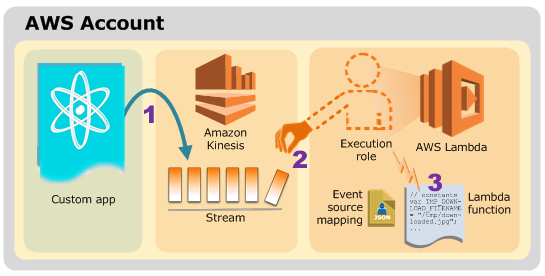
Using AWS Lambda with Amazon Kinesis
- Custom app writes records to the stream.
- AWS Lambda polls the stream and, when it detects new records in the stream, invokes Lambda function.
- AWS Lambda executes the Lambda function by assuming the execution role we specified at the time we created the Lambda function.
Ref : Visualizing Web Traffic Using Amazon Kinesis Streams.
We will be familiarized with streams constructs; specifically streams, data producers, and data consumers.
The tutorial uses a sample application based upon a common use case of real-time data analytics.
We'll create data-processing applications, known as Amazon Kinesis Streams applications.
What Is Amazon Kinesis Streams?
A typical Amazon Kinesis Streams application reads data from an Amazon Kinesis stream as data records. These applications can use the Amazon Kinesis Client Library, and they can run on Amazon EC2 instances.
The processed records can be sent to dashboards, used to generate alerts, dynamically change pricing and advertising strategies, or send data to a variety of other AWS services.
Start the sample application using a AWS CloudFormation template provided by AWS.
The sample application has a stream writer that randomly generates records and sends them to an Amazon Kinesis stream, a data consumer that counts the number of HTTPS requests to a resource, and a web application that displays the outputs of the stream processing data as a continuously updated graph.
- Open the AWS CloudFormation template.
- On the "Select Template page", the URL for the template is provided. Choose Next.
- "Specify Details" page:
- On the "Review" page, select I acknowledge that this template might cause AWS CloudFormation to create IAM resources, and then choose "Create".
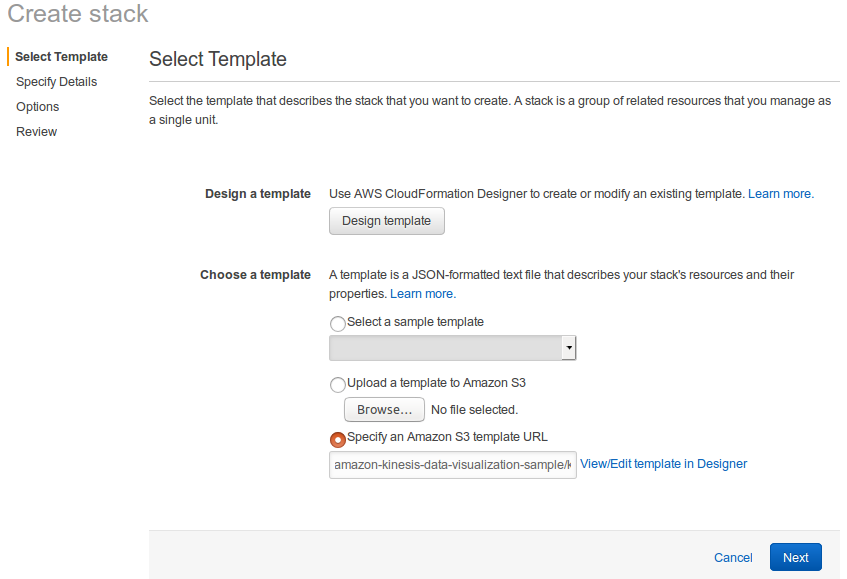
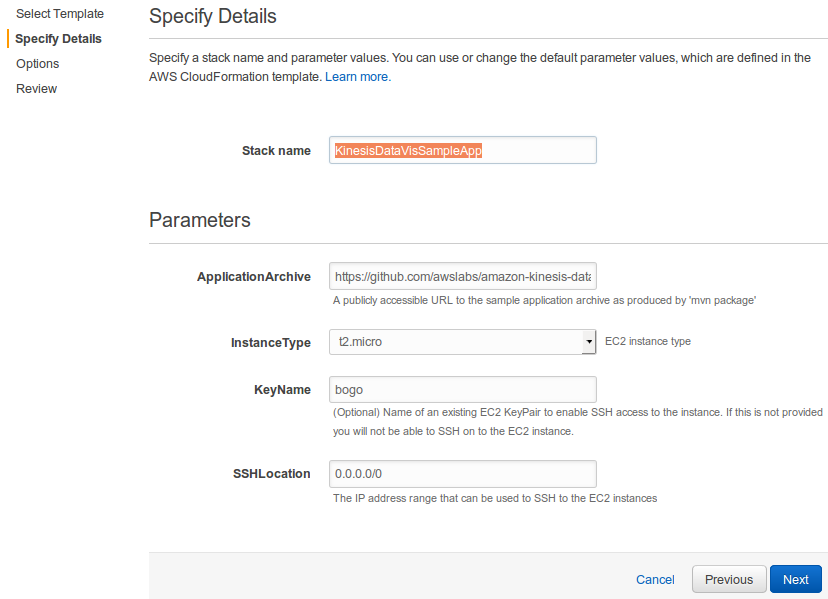

AWS CloudFormation automatically creates the stream for the sample application.
To view the stack details:
- Select the "KinesisDataVisSample" stack.
- On the Outputs tab, choose the link in URL.
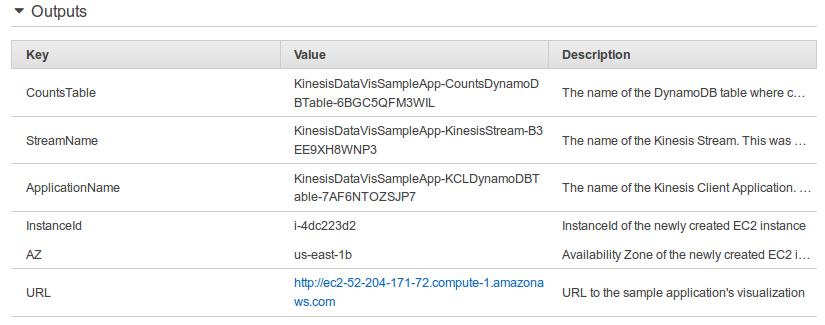
The form of the URL should be similar to the following: http://ec2-xx-xx-xx-xx.compute-1.amazonaws.com. - It takes about 10 minutes for the application stack to be created and for meaningful data to show up in the data analysis graph. The real-time data analysis graph appears on a separate page, titled "Streams Data Visualization Sample". It displays the number of requests sent by the referring URL over a 10 second span, and the chart is updated every 1 second. The span of the graph is the last 2 minutes.
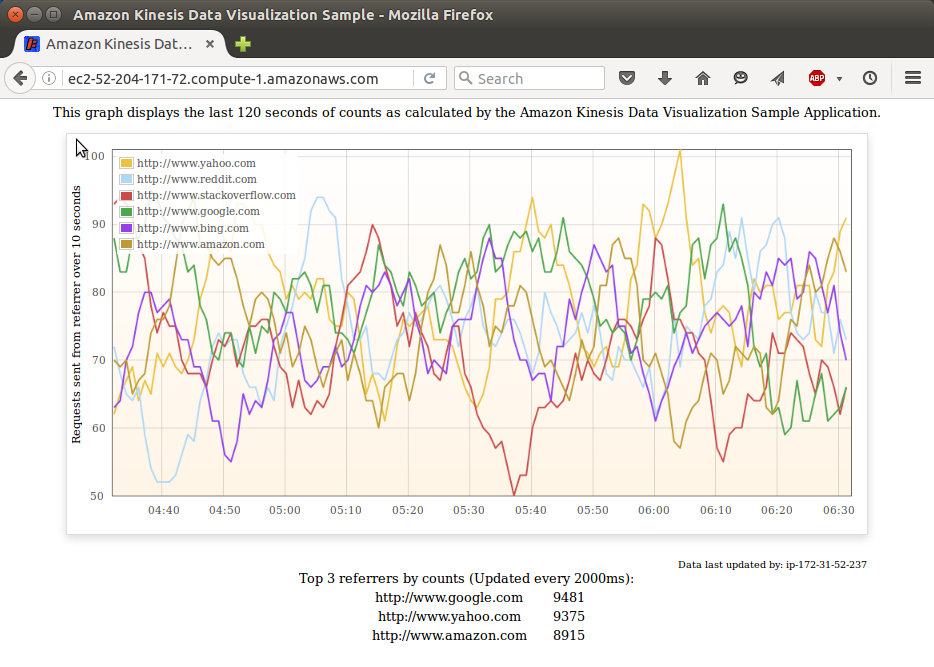
To view the stream details:
- Open the Amazon Kinesis console at https://console.aws.amazon.com/kinesis.
- Select the stream whose name has the following form: KinesisDataVisSampleApp-KinesisStream-[randomString].
- Choose the name of the stream to view the stream details.
- The graphs display the activity of the data producer putting records into the stream and the data consumer getting data from the stream.

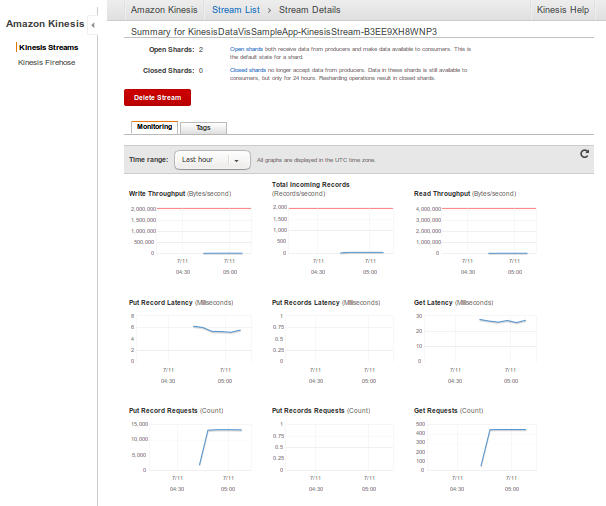
Please check Kinesis Data Firehose with Lambda and ElasticSearch to learn how Kinesis Firehose captures streaming data and transforms the data, and then sends it to ElasticSearch service.
AWS (Amazon Web Services)
- AWS : EKS (Elastic Container Service for Kubernetes)
- AWS : Creating a snapshot (cloning an image)
- AWS : Attaching Amazon EBS volume to an instance
- AWS : Adding swap space to an attached volume via mkswap and swapon
- AWS : Creating an EC2 instance and attaching Amazon EBS volume to the instance using Python boto module with User data
- AWS : Creating an instance to a new region by copying an AMI
- AWS : S3 (Simple Storage Service) 1
- AWS : S3 (Simple Storage Service) 2 - Creating and Deleting a Bucket
- AWS : S3 (Simple Storage Service) 3 - Bucket Versioning
- AWS : S3 (Simple Storage Service) 4 - Uploading a large file
- AWS : S3 (Simple Storage Service) 5 - Uploading folders/files recursively
- AWS : S3 (Simple Storage Service) 6 - Bucket Policy for File/Folder View/Download
- AWS : S3 (Simple Storage Service) 7 - How to Copy or Move Objects from one region to another
- AWS : S3 (Simple Storage Service) 8 - Archiving S3 Data to Glacier
- AWS : Creating a CloudFront distribution with an Amazon S3 origin
- AWS : Creating VPC with CloudFormation
- AWS : WAF (Web Application Firewall) with preconfigured CloudFormation template and Web ACL for CloudFront distribution
- AWS : CloudWatch & Logs with Lambda Function / S3
- AWS : Lambda Serverless Computing with EC2, CloudWatch Alarm, SNS
- AWS : Lambda and SNS - cross account
- AWS : CLI (Command Line Interface)
- AWS : CLI (ECS with ALB & autoscaling)
- AWS : ECS with cloudformation and json task definition
- AWS Application Load Balancer (ALB) and ECS with Flask app
- AWS : Load Balancing with HAProxy (High Availability Proxy)
- AWS : VirtualBox on EC2
- AWS : NTP setup on EC2
- AWS: jq with AWS
- AWS & OpenSSL : Creating / Installing a Server SSL Certificate
- AWS : OpenVPN Access Server 2 Install
- AWS : VPC (Virtual Private Cloud) 1 - netmask, subnets, default gateway, and CIDR
- AWS : VPC (Virtual Private Cloud) 2 - VPC Wizard
- AWS : VPC (Virtual Private Cloud) 3 - VPC Wizard with NAT
- DevOps / Sys Admin Q & A (VI) - AWS VPC setup (public/private subnets with NAT)
- AWS - OpenVPN Protocols : PPTP, L2TP/IPsec, and OpenVPN
- AWS : Autoscaling group (ASG)
- AWS : Setting up Autoscaling Alarms and Notifications via CLI and Cloudformation
- AWS : Adding a SSH User Account on Linux Instance
- AWS : Windows Servers - Remote Desktop Connections using RDP
- AWS : Scheduled stopping and starting an instance - python & cron
- AWS : Detecting stopped instance and sending an alert email using Mandrill smtp
- AWS : Elastic Beanstalk with NodeJS
- AWS : Elastic Beanstalk Inplace/Rolling Blue/Green Deploy
- AWS : Identity and Access Management (IAM) Roles for Amazon EC2
- AWS : Identity and Access Management (IAM) Policies, sts AssumeRole, and delegate access across AWS accounts
- AWS : Identity and Access Management (IAM) sts assume role via aws cli2
- AWS : Creating IAM Roles and associating them with EC2 Instances in CloudFormation
- AWS Identity and Access Management (IAM) Roles, SSO(Single Sign On), SAML(Security Assertion Markup Language), IdP(identity provider), STS(Security Token Service), and ADFS(Active Directory Federation Services)
- AWS : Amazon Route 53
- AWS : Amazon Route 53 - DNS (Domain Name Server) setup
- AWS : Amazon Route 53 - subdomain setup and virtual host on Nginx
- AWS Amazon Route 53 : Private Hosted Zone
- AWS : SNS (Simple Notification Service) example with ELB and CloudWatch
- AWS : Lambda with AWS CloudTrail
- AWS : SQS (Simple Queue Service) with NodeJS and AWS SDK
- AWS : Redshift data warehouse
- AWS : CloudFormation
- AWS : CloudFormation Bootstrap UserData/Metadata
- AWS : CloudFormation - Creating an ASG with rolling update
- AWS : Cloudformation Cross-stack reference
- AWS : OpsWorks
- AWS : Network Load Balancer (NLB) with Autoscaling group (ASG)
- AWS CodeDeploy : Deploy an Application from GitHub
- AWS EC2 Container Service (ECS)
- AWS EC2 Container Service (ECS) II
- AWS Hello World Lambda Function
- AWS Lambda Function Q & A
- AWS Node.js Lambda Function & API Gateway
- AWS API Gateway endpoint invoking Lambda function
- AWS API Gateway invoking Lambda function with Terraform
- AWS API Gateway invoking Lambda function with Terraform - Lambda Container
- Amazon Kinesis Streams
- AWS: Kinesis Data Firehose with Lambda and ElasticSearch
- Amazon DynamoDB
- Amazon DynamoDB with Lambda and CloudWatch
- Loading DynamoDB stream to AWS Elasticsearch service with Lambda
- Amazon ML (Machine Learning)
- Simple Systems Manager (SSM)
- AWS : RDS Connecting to a DB Instance Running the SQL Server Database Engine
- AWS : RDS Importing and Exporting SQL Server Data
- AWS : RDS PostgreSQL & pgAdmin III
- AWS : RDS PostgreSQL 2 - Creating/Deleting a Table
- AWS : MySQL Replication : Master-slave
- AWS : MySQL backup & restore
- AWS RDS : Cross-Region Read Replicas for MySQL and Snapshots for PostgreSQL
- AWS : Restoring Postgres on EC2 instance from S3 backup
- AWS : Q & A
- AWS : Security
- AWS : Security groups vs. network ACLs
- AWS : Scaling-Up
- AWS : Networking
- AWS : Single Sign-on (SSO) with Okta
- AWS : JIT (Just-in-Time) with Okta
Ph.D. / Golden Gate Ave, San Francisco / Seoul National Univ / Carnegie Mellon / UC Berkeley / DevOps / Deep Learning / Visualization